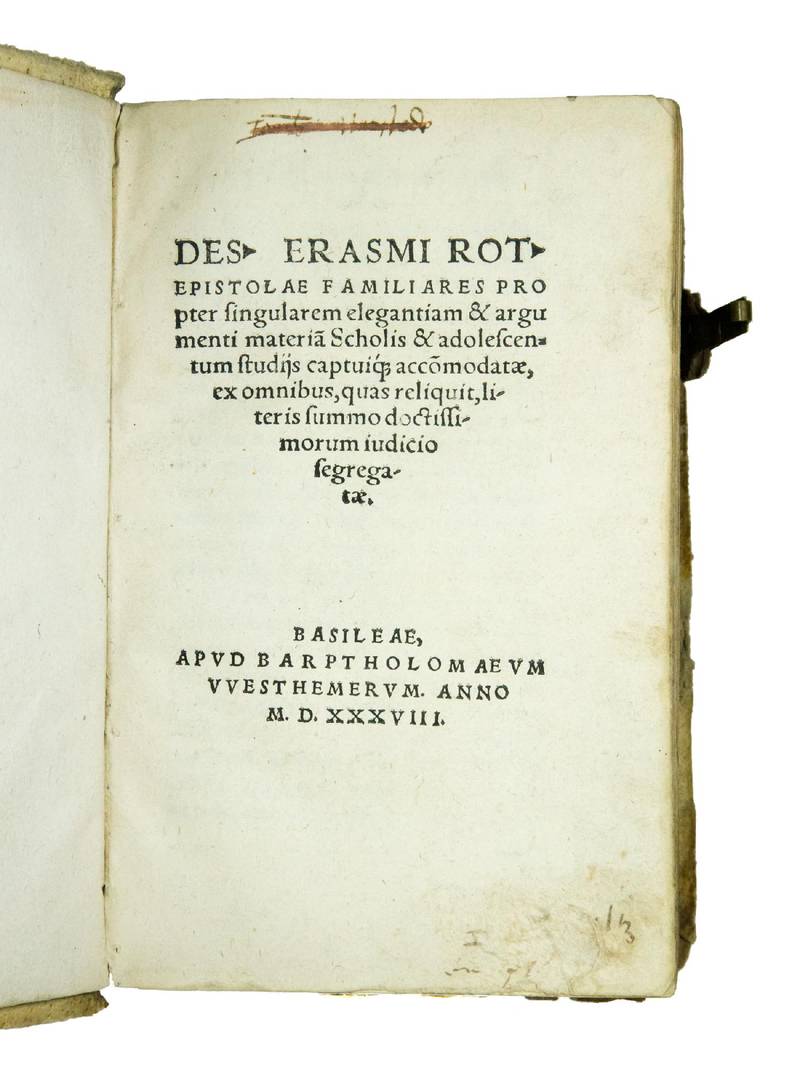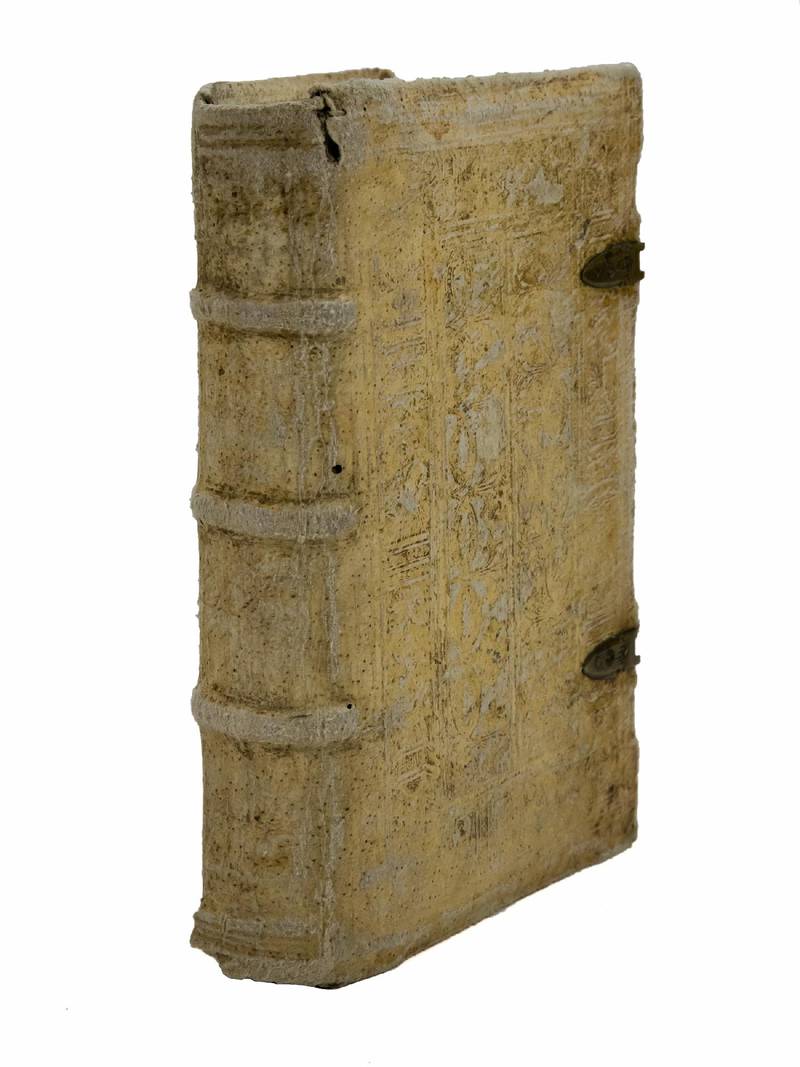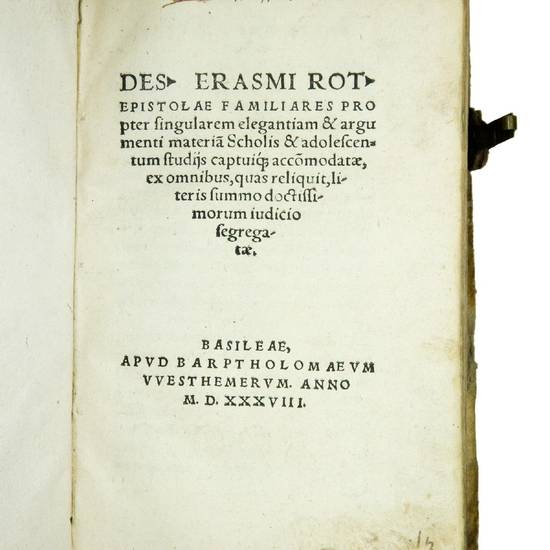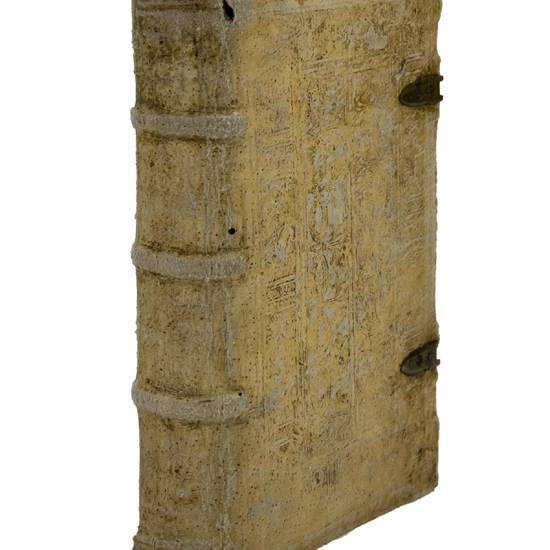Epistolae familiares propter singularem elegantiam & argumenti materia(m) Scholis & adolescentum studiis captiviq(u)e acco(m)modatae, ex omnibus, quas reliquit, literis summo doctissimorum iudicio segregatae
Autore: ERASMUS, Desiderius (1466-1536)
Tipografo: Bartholomaeus Westheimer
Dati tipografici: Basel, 1538
8vo. (16), 477 [i.e. 479], (1) pp. α8, a-z8, A-G8. With the printer's device on the verso of the last leaf. Contemporary blindstamped pigskin over wooden boards, one clasp.
Index Aureliensis, 162.936; VD 16, E-2955; I. Bezzel, Erasmusdrucke des 16 Jahrhunderts in Bayerischen Bibliotheken, (Stuttgart, 1979), 1037; F. van der Haegen, Bibliotheca Erasmiana, I, (Gand, 1893), p. 101.
FIRST EDITION of this selection of Erasmus' letters made from his Opus epistolarum of the same year. The whole volume was intended for school boys as a manual of model letters. The volume opens with the announcement of Erasmus' death and a short biography of the latter by Beatus Rhenanus, and also contains some laudatory verses on Erasmus by Henricus Glareanus and Johannes Sapidus, and an epitaphium by Andrea Alciati. Westheimer reprinted the volume in 1551. The present edition was possibly, although there is no direct evidence, also edited by Johannes Gast (d. 1552), who in 1546 published Desiderii Erasmi Roterodami epistolae familiares in tres centurias divisae.
“Il a une haute idée de la lettre considerée comme un genre littéraire qui ‘peint les moeurs, le destin, les sentiments, les conditions de la vie publique et de la vie privée' tout en maintenenant le ton de la conversation: colloquium inter absentes. Ses préférences vont à la simplicité, au style naturel et familier, à tout ce qui s'écarte résolument des expressions conventionelles, artificielles et impersonnelles. Sans doute, Erasme lui-même n'a-t-il pas toujours suivis ces sages recommandations? Il n'en reste pas moins qu'il n'aurait pu écrire un tel traité épistolaire s'il n'avait été d'abord un gran épistolier. Ajoutons pour mémoire, qu'Erasme n'a pas publié lui-même un recueil de ses plus belles lettres familières. Le volume intitulé Desiderii Erasmi Roterdami epistolae familiares est une édition posthume, chez B. Westhemerus à Bâle en 1538” (L.-E. Halkin, Erasmus ex Erasmo. Erasme éditeur de sa correspondence, Aubel, 1983, pp. 127-128).
Bartholomaeus Westheimer (1499-1567/68) was born at Pforzheim and educated in the Latin school of Johann Sapidus at Schlettstadt. Around 1525 he lived in Rastatt and came into contact with the circle of Reformed theologians like Johannes Brenz and Dietrich von Gemmingen. A year later he settled in Basle as a proofreader, became a citizen and married a former nun. In Basel he issued his first theological works being printed by Thomas Wolff, whose printing shop he eventually took over in 1536. During some of his business trips, he met in Strasbourg the theologian Konrad Hubert with whom he remained in correspondence over a longer period. In 1546 he ceased his activities as a printer and became pastor of Therwil (near Basel) and in 1547 of Mulhouse. In 1551 he returned to Basel and his name is found in the university register. In 1553 he was called as a preacher to Horbourg (near Colmar). With a short stay in Montbéliard (Burgundy) he returned permanently to Horbough.
As a printer he published over one hundred works: classical authors, theological and philological treatises as well as medical tracts, mostly in Latin. As theologian (he had converted from Calvinism to Lutheranism in his later years), he tried to show, combining humanism, biblical studies, and the Church Fathers, that the Reformation is indeed a return to the spirit of the early Church. If he ever had contacts with Erasmus is not known, but it is very probable (cf. H. Rissel, Dem Buch und der Kanzel gedient: Bartholomäus Westheimer aus Pforzheim, 1499?-1567, in: “Neue Beiträge zur Pforzheimer Stadtgeschichte”, Ch. Groh, ed., Stuttgart, 2006, pp. 13-24).
Gerrit Gerritszoon (better known as Desiderius Erasmus) was born at Rotterdam, apparently on October 28, 1466, the illegitimate son of a physician's daughter and a future monk. At Deventer he attended the local school run by the German humanist Alexander Hegius, learning Latin and Greek. On his parents' death he entered the Augustinian College of Stein near Gouda, where he spent six years. At length the Bishop of Cambrai, Henry of Bergen, made him his private secretary. In order to allow him to accept that post, he was given a temporary dispensation from his monastic vows, dispensation that later was made permanent by Pope Leo X.
After taking priest's orders Erasmus went to Paris, where he studied at the Collège Montaigu. He resided there until 1498, gaining a livelihood by teaching. Among his pupils was Lord Mountjoy, on whose invitation probably Erasmus made his first visit to England in 1498. He lived chiefly at Oxford, making the acquaintance of John Colet and Thomas More.
In 1500 he was again in France, living for the next six years mainly at Paris. During this period he wrote the Adagia (Paris, 1500) and the Enchiridion Militis Christiani (Antwerp, 1503). After a short visit to England, in 1506 Erasmus carried out a long-desired journey to Italy, staying chiefly at Padua as tutor to Alexander Stewart, Archbishop of St. Andrews, and Venice, collaborating to the publishing house of Aldo Manuzio. His visit closed with a short stay in Rome.
In 1509 the accession of Henry VIII and the invitation of Lord Mountjoy induced Erasmus once more to settle in England. In this period he wrote the famous Encomium Moriae (first published at Strasbourg or Paris in 1511) and resided mainly at Cambridge, where he was appointed Margaret professor of Divinity and professor of Greek.
After 1514 he lived alternatively in Basel and England, and from 1517 to 1521 at Louvain. In 1516 at Basel appeared the first edition of the Colloquia, usually regarded as his masterpiece, and the first edition of his annotated New Testament. After the explosion of Lutheran revolution, he found himself in the most embarrassing position, assailed on the one side by the Catholic who considered him as the cause of all the new troubles, and criticized on the other side by the Lutherans who accused him for his cowardice and inconsistency in refusing to follow up his opinions to their legitimate conclusions.
In 1521 he left Louvain, where the champions of the old faith had made his stay unendurable and, with the exception of six years in Freiburg, he spent the rest of his life at Basel. In those years he continued publishing a long succession of classical and patristic writers, as well as new augmented and corrected editions of his main works, especially the Adagia, the Colloquia and his epistolary. At the same time he was engaged in continual controversies, on the one side with Protestants thinkers like Ulrich von Hutten and Martin Luther, with whom he exchanged a series of pamphlets about the free will (starting with Erasmus' De Libero Arbitrio, Antwerp, 1524), on the other side with the Catholic theologians of the Sorbonne.
With the publication of the dialogue Ciceronianus (Basel, 1528), he then ruined some old friendships, like that with Guillaume Budé, and raised against himself new adversaries, those humanists, namely, who he accused to set style above matter. Nevertheless during his last years Erasmus enjoyed great fame and consideration all over Europe. He died at Basel on July 12, 1536 and was buried there in the cathedral (cf. C. Augustijn, Erasmus: His Life, Works, and Influence, Toronto, 1991; J. McConica, Erasmus, Oxford, 1991; and L.-E. Halkin, Erasmus: A Critical Biography, Oxford, 1993).
[9150]





